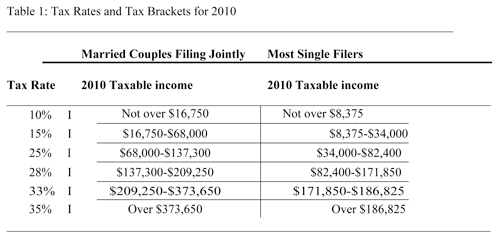November 29, 2010

Year-end tax planning appears confusing as the political climate in Congress changes and Congress remains in a stalemate over extending tax cuts scheduled to expire on December 31, 2010.
Generally, year-end tax planning involves finding ways to accelerate or defer income and/or deductions based on this and next year's potential tax liability. However, because most of the tax cuts authorized by Economic Growth and Tax Relief Reconciliation Act of 2001 (EGTRRA), are scheduled to expire on December 31, 2010, unless Congress acts soon, tax rates will automatically go up for all individual taxpayers, including those subject to the lowest tax rates.
While Congress may not act until next year, tax planning now must concentrate on what we know.
Since the tax cuts enacted by the EGTRRA expire at the end of this year, the income tax rates and other provisions for 2010 will be very similar to last year, except for cuts that expired at the end of 2009.
Small Business Job Act (SBJA)
The Small Business Jobs Act of 2010 (SBJA) signed into law on September 27, 2010, extended some of the business tax cuts that had expired in 2009. Highlights of new or extended SBJA tax provisions include:
Extending and increasing the Section 179 expensing option for depreciable property used in business, i.e., computers, office furniture, equipment, vehicles, or other tangible business property, to a maximum of $500,000 for tax years beginning 2010 and 2011 only. Also, the expensing election now applies to qualified leasehold improvement property, such as any improvements to an interior portion of a building which is nonresidential real property.
Extending the 50percent bonus depreciation deduction for 2010 which was set to expire at the end of 2009, for qualifying property as long as the property is placed into service before January 1, 2011.
Limiting penalties for errors in tax reporting that disproportionately affect small businesses.
Allowing the deduction of cell phone business use without additional documentation.
Temporarily increasing the amount of start-up expenditures entrepreneurs can deduct from their taxes in 2010 from $5,000 to $10,000 (with a phase-out threshold of $60,000 in expenditures).
Allowing certain small businesses (with average annual gross receipts for the preceding three tax years of $50 million or less) to "carry back" general business credits to offset five years of taxes. Also general business credits that arise in tax years beginning in 2010 are allowed to offset AMT for 2010.
Allowing a deduction for the cost of small business health insurance premiums in calculating self- employment taxes.
Tax Breaks Expired
The tax breaks that expired at the end of 2009 include: deduction for classroom expenses for educators, tuition and fees deduction for college, additional standard deduction for property taxes, additional standard deduction or itemized deduction for sales tax paid on a new vehicle, itemized deduction for state and local sales taxes in lieu of state income taxes, tax-free exclusion of the first $2,400 in unemployment benefits and tax-free exclusion of IRA funds donated directly to charity.
In addition, required IRA payments from IRA plans resume this year. Congress did not extend last year's waiver of required IRA distributions (if age 70.5 or more).
Tax Brackets/Standard Deduction
Tax brackets remain essentially the same as last year (See Table 1)

Standard deductions remain
The standard deductions remain the same in 2010 at $11,400 for couples plusanother $1,100 if
elderly/blind (Singles: $5,700 plus $1,400 if elderly/blind). Household heads get $8,400 plus $1,400 if elderly/blind.
Other Provisions: Provisions provided by The Emergency Economic Stabilization Act of 2008 and the 2009 stimulus package.
The $1,000 child tax credit is available through 2010 and reverts to $500 in 2011.
The cost of energy efficiency improvements, such as energy efficient insulation, windows, doors, roofs, heat pumps, hot water heaters or boilers, or advanced main air circulating fans installed in a principal residence, may be entitled to a tax credit of 30% of the purchase price, up to a maximum credit of $1 ,500. This credit will be off-set by the alternative minimum tax (AMT) in 2010, unless Congress changes the rules.
The alternative minimum tax (AMT) amount remains unresolved for 2010. The exemption was increased to $70,950 and $46,700 for joint and single filers, respectively, for 2009 by the American Recovery and Reinvestment Act of 2009. Some Congressmen contend that the AMT exemption for 2010 will be boosted to 72,450 for couples and $47,450 for singles, up $1,500 and $750, respectively, over 2009. In addition, personal tax credits such as the tuition
and dependent care credits will be able to offset the AMT in 2010.
The AMT willrequire tax payers to compute their income taxesunder two systems, the regular tax system and the so-called alternative minimum tax (AMT) system and pay the higher of the two amounts. The AMT will have a greater impact on tax payers with incomes between $100,000 and $500,000 and/or tax payers who deduct a significant amount of state and local taxes (income, property, and/or sales taxes) or miscellaneous itemized deductions (like unreimbursed employee business expenses), or claim multiple dependents exemption.
The Estate Tax was repealed in 2010. Some Congressmen want a $3.5-million exemption with a 45 percent top rate. In later years, the exemption would rise in steps to $5 million and the maximum tax rate would decrease to 35 percent. It appears, however, that the estate tax is not going to disappear.
Reminder: Starting in 2011 rental property owners will be required to issue a Form 1099 (a so-called payee statement for any service provider that is paid $600 or more during 2011) for things like yard care, painting, accounting, etc.
You May Also Like




